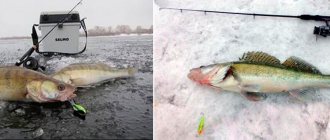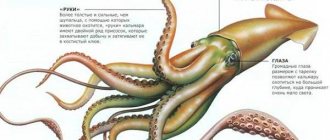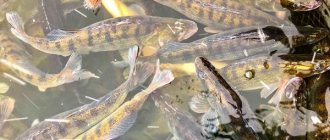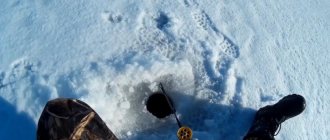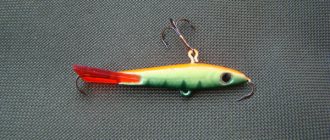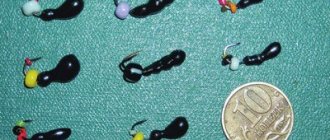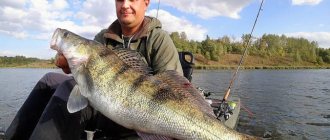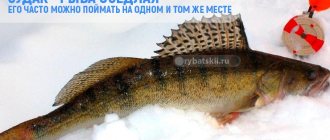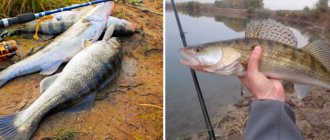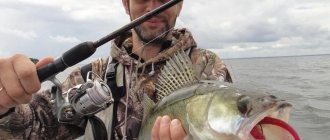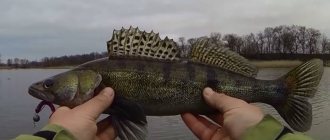Pike perch is highly valued by culinary specialists in all countries where it is found, due to the fact that the meat of this fish is low-fat and practically boneless, and in addition, as many lovers of fish dishes note, it is tasty, tender and very healthy. A huge number of dishes can be prepared from pike perch, so pike perch is the favorite type of fish for most housewives.
In the winter months you can sometimes catch even more pike perch than in the summer. But the way they catch fish in the winter is very different from the way they catch them in the summer.
What to consider when looking for pike perch
In order to find pike perch in the summer, you first need to know the reservoir, the location of depressions and snags on its bottom. But in winter, a school of pike perch will not stand in one place: it must move to find prey. Therefore, the fisherman has to move around a lot in search of this fish, trying to find the most successful fishing spot.
But there is one encouraging circumstance: although the flock moves all the time in winter, it usually follows the same route every year. And if you already know some places for successful fishing, then by repeatedly checking them, you will most likely achieve success. But a school of pike perch does not always behave the same way. Sometimes she may freeze in some place near the bottom and not be interested in either food or bait. It is no longer possible to catch such a pike perch that has fallen into suspended animation.
Rods and reels
Now let's also briefly talk about rods and reels.
I immediately decided that I would go through experiments, so that in the end I would settle on one thing. That's why I'm talking about my experience using fishing rods or, more precisely, ice trolling kits. When choosing a fishing rod for trolling, I set myself several goals. On the one hand, I wanted to satisfy my interest in new products, and on the other hand, to find something that would really “feel right in my hand,” as they say.
Reel tackle
Conductor's baton "ChulanGan" from Andrey Yuryevich Chulanov
As the first set that I chose for trolling and caught several fishing trips with it, I caught several pike perch: an Arctic Char 70H winter rod and an Erebus Eira inertial reel. The very first fishing trips showed that the rod “didn’t fit my hand”; the long handle, huge rings, “deafness” and, by my standards, the most terrible resonance in the hand did not leave the rod any chance of becoming a fishing rod for my nightly adventures. Maybe some people like them, but this is definitely not my option.
The fishing rod didn't take root
But the reel is still catching
But overall I liked the reel. The reel made a good impression on me as a beginner, for whom reels were primarily storage for fishing line, and not another component in the ice fishing technique. And apparently because of this, having completely forgotten that a reel can also help you in fishing, on my first fishing trips I did what I had done 100 thousand times. A fishing rod with a reel on the ice, and hands on the fishing line. But later I overcame the mill-type reflex and brought the fish to the hole purely with tackle. I liked the reel, but the desire to purchase a reel with better performance characteristics grew more and more.
Overall I liked this winter cartoon
Moreover, I made myself a new carbon fishing rod for the reel, which showed excellent results on the very first fishing trips. I wanted a more balanced version of the coil for it.
Eva, carbon, grip - almost spinning
This is how everything is assembled
I scoured the Internet, read reviews and bought myself 13 Fishing Black Betty Free Fall Ghost Ice Reel. A few words about her. The obvious advantages of the reel are its real working clutch and good handle layout. In general, reel gear of this type, where the rod is equipped with a winter multicast, allows you to fish large areas quite quickly.
Got away and moved on
Therefore, this version of the winter tackle has taken root with me during stretch fishing, where it was necessary to quickly float the vibration and quickly make the transition between holes. There is no need to wave your arms and drag the line, you reeled it out quickly, quickly released it and floated the bait, the fisher moved on, etc.
For stretch fishing, this is my favorite option.
Released, waved, caught
But when snag fishing for local fishing, I did not have enough sensitivity in this gear, the resonance and unnecessary vibrations were too much for me and so I switched to fishing rods without a reel at all. I will note that no matter what reel fishing rods I tried, and I tried many different ones, they gave me the feeling of fishing on the edge. The choice immediately fell on the proven fishing rods from Andrei Chulanov, I was not disappointed in them, the very first fishing trips showed that pike perch can be so neat that it is not clear what it was, or the water pulled the flurry, or... Hooking and now 2.5 kg with a vibration in his mouth lies on ice
"ChulanGan" in my hands
Gets both zander and pike
In general, in all strong places I fish with “Chulangans” without reels. It’s not difficult for me to wave my hands once every 30-40 minutes and bring out a fish of more than 5 kg on my fingers, and the sensations are still different, more complete. I’ll also spin reels in winter spinning, but that’s another story...
Winter night jig is a different story
Friends, all memorable fishing trips, excellent trophies, and a short video about winter night ice fishing, I periodically shoot videos on fishing topics. Interesting fishing trips and memorable trophies to everyone!
The video from the series was shot on a phone! Someone on the couch in the evening, someone in a bar or restaurant. And we know that the time spent fishing does not count towards life, we want to live forever and therefore in the evening, as always, we are on the river.
Features of winter fishing for pike perch
This predator is not caught well all winter: when the period of deep winter sets in, lasting about a month, it is practically impossible to catch it. But the rest of the time, pike perch behaves actively and is constantly looking for food, migrating throughout its habitat. Therefore, fishermen need to constantly move and drill new holes, even if they managed to catch a large specimen in one of them. The flock will not stand still, even if there is enough food there. This behavior of pike perch is written in its genes: in order to survive, you must always move, swimming without stopping.
Pike perch prefers reservoirs with clean water. It can be found in rivers with uneven, drifty bottoms covered with sand or pebbles. It avoids thickets of grass and muddy bottoms, so it will not be possible to find it there.
Like many other predatory fish, pike perch bites best on the first and last ice. During this period of time he has the best appetite. But later, as you move deeper into winter, the bite gets worse. The result of catching pike perch also depends on the weather. On a windy day, especially when the wind is blowing from the north, do not expect successful fishing; it is better to sit at home until the snowstorm subsides, the frost weakens and calm, stable weather sets in.
As for the time of day, at the beginning of winter it is best to catch pike perch within five hours in the morning, starting at 6 am, and in the evening from approximately 15:00 to 20:00. But then, when deep winter sets in, the bite begins later: from seven o’clock in the morning, and sometimes from eight.
We identify promising areas for pike perch fishing
So, finding a place to catch pike perch in winter is significantly different from the same process at other times of the year. If in autumn a predator can always be found in deep areas with edges or snags, then in winter everything is different.
In winter, you have to spend more than one hour searching, not only for the place, but for the fish itself. In winter, pike perch constantly moves around a pond following a school of peaceful fish, but this is, of course, subject to favorable weather conditions. In severe frost and bad weather, pike perch hides in holes, from which it is rarely possible to catch it with the most attractive baits.
Admiral spinner for pike perch in winter
Do-it-yourself fang spoon for pike perch
How to choose a spinning rod for catching pike perch
You can wait patiently for a predator on one of the holes that will be drilled above the hole forever. There are more chances of catching a predator with an active search. The predator will always be a few meters away from a school of peaceful fish (roach, bream), so if you know where anglers catch this fish, then you can try to catch pike perch 10-15 meters from the main concentration of anglers.
Important! Pike perch does not change its routes, so if you know where the predator bit well last winter, you can immediately go to these areas.
The most promising places for catching pike perch in the winter months will be areas with a depth of more than three meters. The predator is found near the exits of wintering pits. When searching for a place, you should pay the most attention to areas with snags, flooded logs; pike perch likes to set up ambushes among large stones.
What gear to choose
If the type of fishing rod when fishing for pike perch in winter is not important (but it’s still better if it comes with a reel), then the thickness of the fishing line is important: the thinner and more transparent the fishing line, the more bites there will be. Usually choose a fishing line with a diameter of 0.1 to 0.3 millimeters, and long enough.
The nod, which ensures smooth play of the tackle, is also a mandatory component of the equipment of the fishing rod. Pike perch have a habit of first gently touching the bait before grabbing it. Therefore, you need to choose a nod design in which it has good sensitivity.
Tackle for catching pike perch in winter
As for the design of gear for catching perch, everything is simple. Take the most ordinary fishing rod for winter fishing of medium hardness. The presence of a coil is desirable, but not required. The main task of the reel is to store a supply of fishing line. You can use fishing rods with a reel.
Particular attention should be paid to the nod with which the tackle is equipped. The presence of a nod allows you to ensure smooth play of the bait, as well as timely notice the bite of a predator. It is recommended to buy nods made of metal, but you can also use plastic options. The length of the nod is adjusted during the fishing process and is determined based on the weight of the artificial bait. It is important that the nod under the weight of the bait does not deviate more than 20 degrees.
Choosing a place for winter fishing. Where to drill holes?
Making wabiks with your own hands
Review of winter gear for pike perch
As for the fishing line, fishermen use options with a cross-section of 0.18-0.25 mm, here everything depends on the fishing conditions, as well as the weight of the intended trophy. To catch pike perch weighing up to 1.5 kg, it is enough to use 0.18 mm fishing line. Note that the thinner the line, the more sensitive the tackle will be, and, consequently, the greater the chance of catching a cautious predator.
Something about the spinner
They catch pike perch in winter using a variety of types of bait. But most fishermen choose a spoon. Small to medium in size and usually silver in color and narrow in width. So that it resembles fry, which are the favorite food of pike perch. If there is a large current in the river, it is advisable to equip the spoon with a sinker, choosing its weight depending on the depth at which you will catch pike perch. If there is a large pike perch in the reservoir, then the length of the spoon should be 7...9 cm, and if small, then from four to six centimeters.
How to fish with a jig
It is better to choose jigs with a length of about 10...14 millimeters, or even 20 millimeters. And depending on the depth. For greater depths, it is better to take a large jig, designed for catching pike perch of impressive size and weight. You can increase the weight of the jig using lead or other metals that weigh more than lead. If you melted lead onto your jig yourself, wash it thoroughly after that, since pike perch may not like the foreign odors emitted by “burnt” lead. The best option is to coat the jig with silver. The bait can be used in the form of a bunch of bloodworms or a piece of fish.
You can fish with a “devil” or a jig with one hook (with a “drop”, “pellet”, “ant”, etc.), you can tie red strings to them.
The technique of presenting the jig is slow and smooth, with swaying, forcing the pike perch to pay attention to the bait.
You can lower the jig to the bottom so that a cloud forms from the impact, then, after knocking, pause for about five seconds and knock again. The cloud of turbidity that appears when it hits the ground is similar to the cloud created by fry usually darting around the bottom. Such imitation can provoke an attack by pike perch and cause a bite.
You can also use the technique described below. The jig is raised, swinging a little, 30 cm, then the line is loosened and, allowing the jig to move with the flow, it is lowered again, rocking and pausing. After which they begin to drag the jig along the bottom. As a rule, pike perch bites at the moment when the bait comes off the ground.
The hook should be sharp, and it’s better to do two of them to make sure that you really hooked the pike perch.
Lures for winter night fishing for pike perch from the shore
Just like during summer fishing, you shouldn’t limit yourself to a certain arsenal. The set of wobblers should be variable, with different weights and depths, shapes and colors, both sinking and floating. This is due, first of all, to the fact that the location of the predator is constantly changing.
Despite the fact that the model range of these lures is constantly changing, new products appear, and along with this, old lures have natural wear and tear, preference should be given to minnow-type wobblers in the length range from 8 cm to 9 cm. But as mentioned above, you should not neglect the presence of crank baits, shads, or deeps.
Based on existing fishing experience, the acoustic effect of bait during winter night fishing for pike perch does not have any serious impact. However, when hunting in large bodies of water, it is advisable to use wobblers with a long-distance casting system based on adding an eccentric in the form of a moving metal ball to its body.
The color scheme, on the contrary, is of fundamental importance and directly affects the successful outcome of fishing. You should lean towards wobblers with a bright, often acidic color, including glare, which is necessary when fishing in a beam of light, or simply whitish colors. The primary thing in night fishing is to attract the attention of the predator, after which the skill of the game comes into play, guaranteeing the capture of the fanged predator. So, to summarize, we can highlight the main colors that are noticeable at night:
- bright, so-called “poisonous” colors;
- transparent fluorescent color, or with a “broken glass” effect;
- classic white.
Below we will consider some models of wobblers that have successfully proven themselves in winter fishing for pike perch at night. Of course, there are other options, but this greatly depends on the characteristics of the reservoir and the preferences of its representatives:
- The first pair is represented by wobblers Zip Baits Rigge 90F and Nories Laydown Minnow Regular SP Silent, having lengths of 9 cm and 8.8 cm, respectively. The masses are 9.5 grams and 9.9 grams at a depth of 1 m and 40 cm. The first is effective during severe cold spells near the coastline on ridges and shallows, presented in coloring under code 806R. The second is color coded 220, is used in deeper layers of water, has a rig of three treble hooks, which increases the chance of a successful hook-up, and is also completely silent when retrieved.
- The second pair can be classified as so-called irritating elements, which are used to check the location and activate the predator’s bite by arousing aggression in it. These are models of wobblers Smith Jib 90F and Ima Sasuke SF 95. The first has a mass of 6.7 grams and a working depth of 50 cm with a body length of 9 cm. The second is somewhat heavier, weighs 8 grams and sinks up to 60 cm, while its own size is 9.5 cm. They have a differential, highly variable nature of play. If Smith, even with smooth wiring, starts a nimble, chaotic game, then Ima belongs, rather, to the class of twitch baits that require sharp pulls. The peculiarity of the latter is that it can be used as a walker, thanks to its special balancing. Both models have a strong “acid” coloration.
- The third pair is a representative of models with the “broken glass” color, this is the already mentioned Zip Baits Rigge 90F and the free-standing Smith Cherry Blood SR 90 with a length of 9 cm, a weight of 9.4 grams and a working depth of 1 m. The first is color coded 510R, and the second is numbered 08. It should be noted here that Cherry Blood, like Ima, requires a twitch technique and frequent jerks, especially at the beginning of the retrieve. It is also characteristic that this bait is easily cast over a very long distance.
- A separate item should include representatives of the budget line, who are indispensable for a thorough study of a new promising location and will not leave negative impressions from their loss. These are Tsuribito Jerkbait 80F (length 8 cm, weight 8.1 g, working depth 1 m), Liberty Dandy 90F (length 9 cm, weight 10.9 g, depth ceiling 1 m), Ecogear SX 60 (length 6 cm, weight 6.5 g, wiring depth up to 2 m), Smith Depthy Do 1 (length 5.6 cm, weight 8 g, immersion up to 1.8 m).
We recommend reading: Choosing a spinning rod for fishing from the shore, review of current models
Separately, when winter night fishing for pike perch from the shore, you need to pay attention to the gear itself. So, in order to ensure the longest cast, it is necessary to use thin cords, for example, Yamatoyo Famell PE SW Super with a diameter of 0.8. By the way, if you cut off about 1 m of the end of the line before each fishing trip and tie the knot after each fishing, you can avoid unpleasant moments with sudden breaks during sharp jerks. It also helps to treat the cord and guide rings with Johnson's Baby moisturizing oil or silicone grease to prevent ice from forming.
The spinning blank should be as versatile as possible, have a fast action, a sensitive whip and have a safety margin. Of the specific models for various weather conditions, the following fishing rods can be recommended:
- Smith TLB 69DT, in mild frost and snowy coastline;
- Major Craft RZS 702M, for clear, frosty days and shores without snow.
How to catch pike perch using a balance beam
The balancer is a relatively new type of bait, and today there are not many winter fishermen who already have extensive experience in fishing using balancers.
Modern fishing techniques with balance beams, as well as various new models of them, appeared somewhere at the beginning of this century. But learning the wisdom of this type of ice fishing will not be difficult even for a beginner. When a balancer is used, bait is put on it: a small piece of fish.
The peculiarity of pike perch is that it usually does not pursue its prey. Therefore, when using a balancer, the spoon is played, but not shaken, taking short pauses between movements. So, for example, having lowered the spoon all the way to the ground, you need to lift it 20 cm, then extend it another 50 cm and stop for a short period of time. Next, the spoon must again be lowered to the bottom and a longer pause, approximately equal to 15...20 seconds, must be maintained so that the vibrations of the spoon are completely damped.
If after such a series the pike perch does not bite, then you can try to lift a little mud from the bottom by knocking on the ground. This technique often leads to a bite.
In winter, pike perch’s bites, although sharp, are weaker than in summer, and he himself behaves more calmly and offers less resistance when he is pulled out. Therefore, the fishing rod must have high sensitivity, since the pike perch even takes the bait very carefully. And when you feel a bite, you need to hook sharply so that the hook can pierce the upper lip of the fish. Otherwise, when she approaches the hole, she may release the bait and swim away. The bite of the pike perch is sharp, because by inertia it follows the flock, holding the bait in its mouth, or it wants to go down with the prey.
Pike perch hunting area
In general, places that are promising for catching pike perch can be identified using three main features:
- the presence of sandbanks where bleak or minnows can be found, which become the main prey of the fanged predator;
- rocky ridges with a depth difference of at least 1 meter, which are densely populated with food supply for small fish, which, in turn, attracts pike perch as a predator;
- coastal slopes into the water are promising, since sharp changes in altitude make it convenient for predatory fish to ambush; pike perch is no exception and adheres to different thicknesses of water.
Recommended reading: Equipment
Diversion and drainage channels, streams and springs are also of keen interest to predatory fish, since flows of incoming water can have an upward temperature gradient, as well as bring additional food suspension, which will attract schools of peaceful fish. In such segments of reservoirs you can always observe a concentration of roach, minnows, bleaks, etc.
Success can also be called the case when the fisherman managed to discover a combination of these features that characterize a promising place. For example, it could be a jet of warm current formed by a canal or stream, which then passes over a ridge or spit, abruptly changing to a hole. The probability of detecting a predator in such places tends to one hundred percent.
Winter fishing
If you decide to catch pike perch using a zherlitsa, you should keep in mind that you need to take a large amount of fishing line with you in order to take into account the behavioral characteristics of this fish. The fact is that pike perch, after capturing prey, usually swims with it for another thirty meters. Therefore, the reel must have a lock to slow down the line.
And the reel itself must be installed so that it is raised above the ice by approximately ten (or a little more) centimeters.
You can use a bait of any design, but it is better with one hook, since the presence of several can frighten the pike perch, and it will avoid such bait. The optimal weight of live bait is 20...30 g. It’s a good idea to take a small hook for fishing, so that the moment the pike perch appears in the hole, hook it and pull it out onto the ice.
Winter tackle for pike perch on sprat
Pike perch is a large predator. Sometimes fishermen come across specimens (weighing more than 10 kg). To catch this fish, you can use various winter gear. For example, you can catch pike perch using sprat.
Tulka is a small fish. If necessary, you can buy it at a fishing store.
For sprat fishing you will need the following winter gear:
- Hooks. Fishing stores offer a wide range of hooks. You should give preference to triple and double hooks. Such hooks have a high probability of a successful hook. The cost of such hooks varies from 50 to 500 rubles. It is better to choose hooks made of high-strength steel. These hooks are sharp and high quality.
- Fishing line. Some fishermen use braid. But when using such a fishing line, troubles can arise. For example, the braid may become tangled. If it gets tangled, then knots are formed. And it's difficult to untangle them. Therefore, give preference to monofilament fishing line. This line is suitable for catching medium and large pike perch. The thickness of the monofilament line should be 0.2–0.3 mm.
- Nod. Pike perch is a cautious fish. In winter she becomes less active. Therefore, bites occur less frequently. To catch pike perch in winter, fishermen use a steel plate nod. And you can also use a nod, which is made from a spring. The main requirement for a nod is high sensitivity.
- Coil. To fish with sprat you need to use a large reel. And the supply of fishing line should be 30–50 m.
- Fishing rod. You will need a strong fishing rod. The length of the fishing rod can vary from 50 to 100 cm. And it is also necessary to choose the right whip. It must be very tough.
- Tulka. You can buy it at a specialty store or catch bait yourself.
The sprat must be placed correctly - closer to the tail. The sprat must be placed across the body when fishing in the current.
Fishing with a bulldozer
“Balda” is a weight tied at the end of a fishing line, with two hooks with beads hanging freely on a ring. The bait is lowered to the bottom and tapped on it. At this time, the hooks rise, oscillate and seem to wave their “hands”, like a small crustacean or a bug. Then the “balda” is thrown up low and lowered down again. Movements during such a game should be smooth and sweeping, and the nod should describe ovals.
The main thing to follow when making your own “balda”: the bait must be symmetrical in design.
Building such a bait is not at all difficult if you have already found a sinker of a suitable shape, two hooks and about 10-15 beads.
We also recommend that when catching pike perch, you should be guided by a folk superstition: if you catch a small thing, it is better to let it go, otherwise the rest of the catch will be the same.
